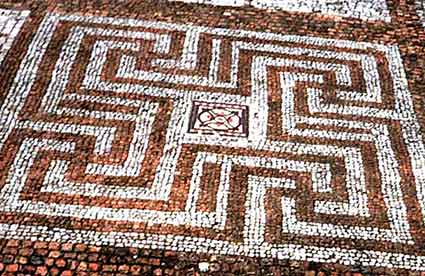Rockbourne Roman Villa

Rockbourne Roman Villa lay undisturbed for centuries until in September 1942 a local farmer found oyster shells and tiles whilst digging out a ferret on the old village cricket ground.
A Fordingbridge estate agent and enthusiastic antiquarian, Mr. A.T. Morley Hewitt, was alerted to the finds and, suspecting their significance, opened up a trial trench that, as luck and / or skill would have it, revealed a Roman mosaic floor just 18" below the surface of the ground.
Other small scale exploratory works were subsequently undertaken until in 1956, after purchase of the land, Mr. Morley Hewitt was able to begin the significant excavations that would continue until 1978.
Finds at Rockbourne Roman Villa have included impressive mosaics, 3rd and 4th century sherds from pottery manufactured in the New Forest, a child's feeding cup and a large numbers of coins including a hoard of 7,717, mostly from the period 250 - 290 AD, hidden away in a two-handled storage jar.
Perhaps the most gruesome discovery, however, was that of a man's skeleton buried face downwards after the amputation of his feet and right forearm, which are apparently indications of Saxon execution. The poor unfortunate had also survived trepanning, that is, he had had a hole cut into his skull, possibly to 'let out the devil' or as a perceived cure for epileptic seizures, migraines, mental disorders or other infirmities!
Now known to have once been the centre of a large farming estate, Rockbourne Roman Villa is the largest known villa in the area, with a history that dates from the late Iron Age to the 5th century AD. Mosaics, part of the under-floor heating system and the outline of the villa's forty rooms can be seen, and there is a museum on the site where some of the finds are displayed.
A little to the south of Rockbourne Roman Villa is the Eyre Coote Monument, which stands at over 100 feet high. Erected in 1828, it commemorates principally Lieutenant General Sir Eyre Coote (1726 - 1783), who is perhaps best known for his role as a senior officer in the British Army, serving in India. The Coote's nearby family mansion, West Park, was demolished soon after World War Two. (The Eyre Coote Monument is not open to the public, although occasional visits are organised by, for example, the New Forest National Park Authority).
Further information about Rockbourne Roman Villa, including details of arrangements for visitors, can be found here - Rockbourne Roman Villa.
Quick linksMore links
Search this site

Sadly, 58 animals were killed - 35 ponies, 13 cows, 8 donkeys and 2 sheep, whilst a further 32 were injured - 3 pigs, 9 donkeys, 11 cows and 9 ponies.
(Forty-three accidents occurred in daylight, 15 at twilight and 101 in the dark. Twenty-seven accidents were not reported by the driver involved).
Here's just one horrific example - Three donkeys killed in collision with van at notorious New Forest blackspot (Advertiser and Times)

